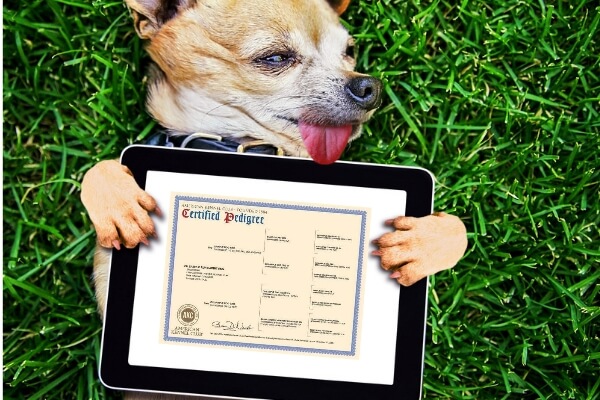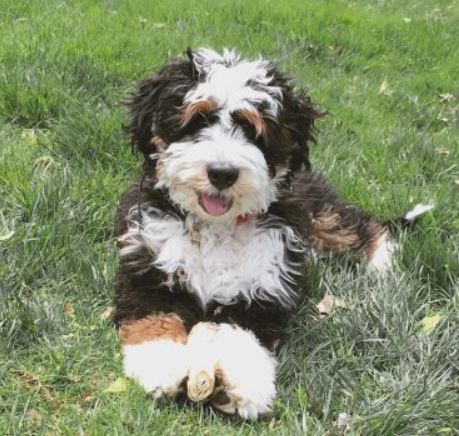Why Do Dogs Like Eating Period Pads? (7 Reasons & What To Do)

When you first adopted your furry friend, you may have braced yourself for chewed-up shoes and gnawed-on furniture, but the sight of your canine companion rummaging through the trash and digging out feminine hygiene products likely caught you off guard. Whether we find it mildly amusing, deeply distressing, or downright disgusting, the truth is that dogs are mysteriously drawn to weird objects such as period pads, tampons, and even used condoms.
Dogs are guided by their senses, with their sense of smell being predominant over the rest. A dog’s world is a spectrum of scents, each of which offers a treasure trove of information. Menstrual pads, saturated with unique biological scents, produce a mixture of pheromones that are particularly intriguing to dogs. This offers them a wealth of information about the human’s health or emotional state, and combined with their curiosity and scavenging instincts, it is quite difficult for them to not be attracted to these used period pads.
This article aims to unravel the mystery behind this peculiar fascination, examining why dogs are attracted to menstrual pads, the potential dangers this poses, and what steps owners can take to manage this behavior. If you have experienced your dog chewing on your menstrual pads in the past, you may want to stick through this article and see the reasons for that.
Read Also: Why Does My Dog Acts Weird When I’m On My Period?
Jump to Section
Reasons Why Your Dog Likes Eating Period Pads
Although very disgusting to humans, eating period pads is not necessarily uncommon in dogs. The reasons behind this behavior are multifaceted and can often be attributed to a combination of factors.
1. Scavenging Instincts
Dogs, as descendants of wolves, have a strong instinct to scavenge. This means they are naturally inclined to explore and investigate different smells and tastes, even if those items might seem unsavory to humans. Your Sanitary pads, especially used ones, carry a uniquely strong smell that can pique a dog’s curiosity and prompt them to eat the object.
2. Your Pheromones Attract Them
All Dogs have an incredibly keen sense of smell, up to 10,000 to 100,000 times more acute than humans. This makes them particularly sensitive to pheromones, which are chemical signals excreted by animals (including humans). The blood and tissue found on your used period pads contain these pheromones, which attract your pooch to the pads and compel him into consuming them.
3. Information-seeking Behavior
Our four-legged furry companions use their mouths much like we use our hands to explore their world. They gather information about their environment by smelling and tasting. This behavior is an important part of their communication and understanding of their surroundings. Eating a period pad may provide them with information about their owner’s health or status.
4. Pica
Pica is a medical condition characterized by an animal eating objects that aren’t food. If your dog repeatedly eats non-food items like period pads, they might be suffering from pica. This condition can stem from various causes including nutritional deficiencies, brain diseases, or behavioral issues. If you suspect your dog has pica, it’s essential to consult a vet for a proper diagnosis and treatment.
5. Boredom or Anxiety
Dogs need mental stimulation and physical exercise to stay happy and healthy. If they’re not getting enough of either, they may resort to destructive behaviors, including eating objects like period pads, out of boredom or anxiety. These behaviors can be mitigated by providing your dog with plenty of playtimes, attention, and appropriate chew toys.
6. Fido Is Hungry
Sometimes, a dog might eat unusual items simply because they’re hungry and the item smells interesting. If your dog isn’t receiving enough nutrition from their regular meals, they might try to supplement their diet with other objects, including period pads. Regular, balanced meals and enough water intake are crucial for your dog’s health.
7. Medical Reasons
Some medical conditions may prompt your dog to eat non-food items. Gastrointestinal diseases, diabetes, thyroid disease, or parasitic infections can lead to increased appetite and unusual eating habits. If your dog is eating period pads, it’s important to rule out any potential medical causes by consulting with a vet.
Although it is not uncommon for dogs to eat period pads if your pooch has done this, it is crucial to get in touch with your veterinarian right away. These pads can cause serious health problems if ingested, such as intestinal blockages that may require surgical intervention. Make sure to keep such items securely disposed of and out of your dog’s reach to prevent further incidents.
Why Is Eating Period Pads Dangerous For Dogs? (Dangers)
While dogs’ penchant for eating all sorts of unusual items might sometimes seem amusing, it can also lead to serious health problems, particularly when the items consumed are not meant for ingestion. This is the case with period pads, an item that many dogs seem inexplicably attracted to. Eating period pads is not just an odd behavior; it can be a hazardous one. Understanding the following risks associated with this behavior is a vital part of ensuring your dog’s health and safety
1. Intestinal Obstruction
One of the main risks associated with a dog consuming a period pad is the potential for an intestinal obstruction. Pads are designed to absorb fluids, meaning they can expand in a dog’s stomach or intestines after being eaten. This can cause a blockage, which prevents the normal passage of food and can lead to serious complications, including vomiting, abdominal pain, loss of appetite, and in severe cases, a potentially fatal rupture of the intestines.
2. Choking
Period pads, especially if consumed whole or in large pieces, can also pose a choking hazard. Dogs might not chew the pad thoroughly before swallowing, which could make the pad to get lodged in the throat causing excessive drooling. This situation can lead to immediate respiratory distress and can be life-threatening if not promptly addressed.
3. Infection
If the pad has been used, there’s a risk of bacterial infection. The warm, moist environment of a used pad is a breeding ground for bacteria. If ingested, these bacteria can potentially cause gastrointestinal infections, resulting in symptoms like diarrhea, vomiting, and loss of appetite.
4. Digestive Tract Injuries
In addition to causing obstructions, the material of the pad can potentially cause injury to the digestive tract. As it moves through the esophagus, stomach, or intestines, the pad can cause scratches or tears. These injuries can lead to internal bleeding and may require surgical intervention to repair.
5. Exposure to Chemicals
Many period pads are made with synthetic materials and may contain various chemicals, including fragrances, dyes, and super absorbent polymers. These substances are not meant to be consumed and, when ingested, can potentially lead to toxic reactions in a dog’s system. Symptoms of toxicity can include excessive drooling, vomiting, diarrhea, lethargy, and in severe cases, seizures.
These hazards underscore the importance of keeping period pads, along with other potential foreign objects, out of your dog’s reach.
Signs That Your Dog Has Eaten Period Pads
Understanding the signs that your dog may have consumed a menstrual pad is crucial to respond promptly and ensuring your pet’s safety. Here are the symptoms your pooch can suffer if it had consumed menstrual pads.
Lethargy: Lethargy in dogs involves a lack of energy or enthusiasm. You may notice your dog sleeping more than usual, being slow to respond to stimuli, or simply showing less interest in activities they usually enjoy. You might want to check what he has consumed immediately if this is the case.
Vomiting: If your dog vomits, it could be a clear sign that something is upsetting their stomach. This could range from a minor stomach upset to a severe obstruction caused by the consumed pad.
Diarrhea: Loose or watery stools could indicate that your dog’s digestive system is trying to quickly expel something harmful, such as parts of the menstrual pad. Pay close attention to your dog and find out if he exhibits this symptom.
Constipation: On the other hand, constipation, or difficulty passing stools, might suggest a potential blockage in the digestive tract – a serious condition that might occur if a dog has eaten a menstrual pad.
Excessive Drooling: While dogs naturally salivate, excessive drooling could be a sign of nausea or discomfort, possibly indicating that they’ve consumed something they shouldn’t have.
Nausea: Beyond drooling, other signs of nausea in dogs include listlessness, continuous lip smacking or licking, and retching without bringing anything up.
Disinterest in Food: A sudden disinterest in food could be a sign your dog isn’t feeling well. If your dog is usually enthusiastic about meals but now shows reluctance or indifference, it might indicate an upset stomach or worse.
Reduced Appetite: Similarly, a reduced appetite over some time could be a sign that your dog isn’t feeling well or is experiencing discomfort in their digestive tract.
If you observe one or more of these signs in your dog, it’s important to consult with a veterinarian as soon as possible. Swallowed menstrual pads can cause serious health problems, including dangerous blockages that might require surgical intervention.
What To Do When Your Dog Has Eaten Sanitary Pads
While it may seem humorous at first glance, your dog eating sanitary pads is no laughing matter. It poses serious risks to your furry friend’s health and requires immediate attention. Here are the steps you should take when you find yourself in this unexpected predicament.
1. Move The Pads Away From Fido And Secure Him
The first thing you need to do is to ensure that your dog doesn’t eat any more of the sanitary pads. Remove any remaining pads and dispose of them in a secure, dog-proof trash can. Dogs are opportunistic eaters, and it’s essential to remove the source of temptation immediately.
Next, confine your pet in a safe space where he can’t access any more dangerous items. This could be a secure room or a crate if he’s comfortable in one. If your dog is showing signs of discomfort or distress such as retching, vomiting, abdominal pain, loss of appetite, or altered behavior, note these down for later reference.
2. Gather Necessary Information
Once your dog is secure, gather as much information as you can. Try to estimate how many pads your dog has eaten and how long ago the ingestion might have occurred. Note the size, brand, and any specific characteristics of the sanitary pads. Some are infused with fragrances or other additives that could affect your pet’s health.
Your dog’s age, breed type, size, and weight are also necessary information to note while awaiting the arrival of the vet. This can help in knowing the course of action to take.
It’s also helpful to monitor your dog for signs of distress, discomfort, or changes in behavior. If possible, examine his feces for any evidence of the pads – this can indicate if he has started to pass the material.
This information is crucial for the vet to make an accurate diagnosis and to determine the best course of action.
3. Call Your Veterinarian
Contact your vet as soon as possible. Based on the information you provide, they’ll advise you on the next steps. They may ask you to bring your dog in immediately, or they may instruct you to monitor him for specific signs.
In some cases, the dog’s body may be able to pass the foreign material without intervention. However, if the ingested pad obstructs the digestive tract, surgical intervention might be necessary.
The veterinarian will likely conduct a physical examination, and may also use imaging studies like X-rays or ultrasound to assess whether the sanitary pad is causing a blockage.
Always note that each dog is unique and responses can vary, so it’s crucial to stay vigilant for any changes in behavior or symptoms. Always prioritize reaching out to a professional for advice to ensure your pet’s safety and well-being.
Is It Okay For Dogs To Lick Period Blood?
While blood may generally not be harmful to dogs, it’s not a great idea to allow them to lick period blood off your pad because it’s highly contaminated with microbes from the female genitalia or the environment.
Also, sanitary products such as pads or tampons, if consumed by a dog, can lead to serious health issues. These items are not designed to be digested, and if swallowed, they could cause blockages in the dog’s digestive system, leading to a potentially life-threatening situation that requires emergency veterinary intervention.
Another reason to discourage this behavior relates to potential behavioral issues. Dogs, being creatures of habit, learn quickly from their experiences. If they are allowed to lick or consume menstrual blood, they may start to develop a particular fascination or preference for it. This learned behavior could potentially lead to problems. For instance, they might begin to seek out blood or related scents aggressively, which could lead to invasive behavior, particularly around menstruating women. They may also attempt to access sanitary products, leading to the risk of ingesting harmful objects.
Finally, it’s important to consider the psychological aspect. Many people may find the behavior of a dog licking or showing interest in menstrual blood to be distressing or simply unhygienic. This could negatively impact the relationship between the dog and its human companions, potentially causing anxiety, discomfort, or even fear.
Ways To Keep Your Dog Out Of The Bathroom Trash Can
Keeping your dog out of the bathroom trash can be a bit of a challenge, but it’s necessary for the health and safety of your pet, not to mention the cleanliness of your home. There are a few strategies you can employ to make this happen.
Firstly, it is vital to train your dog to understand boundaries within your home. Canine training is a fundamental component in managing your dog’s behavior. Training should begin when the dog is young, but it’s never too late to start. Basic commands such as ‘leave it’, ‘sit’, ‘stay’, and ‘off’ can be highly effective when applied consistently. Teaching your dog to understand these commands will discourage them from rummaging through the bathroom trash can or any other undesired areas. Positive reinforcement, such as treats and praise when they obey, can significantly hasten the learning process.
If your dog doesn’t respond to training, or if it takes a while for them to get the hang of it, you might want to consider some physical barriers. The simplest and most obvious solution is to keep the bathroom door closed. This is an effective and straightforward way of keeping your dog out. But if you have a home where doors are frequently left ajar, it might be more practical to install a small, pet-proof gate. These are typically easy to step over for humans but difficult for a dog to bypass.
Moreover, modifying the trash can itself can be another way to limit your dog’s access. This can be done by opting for a trash can with a locking lid, or one that is designed to be dog-proof. These are usually heavier, making it hard for the dog to knock them over, and have a mechanism that the dog can’t open. Additionally, consider placing the trash can in a cabinet or elevated area where it’s out of your dog’s reach.
However, some dogs may be persistent, so it’s crucial to eliminate the appeal of the trash can. Frequently, dogs are attracted to the scent of the items thrown away. Regularly emptying the trash can, especially when it contains particularly enticing items like used tissues, dental floss, or food wrappers, can help reduce its attraction. You can also use an odor neutralizer to mask any scents that might tempt your pet.
Lastly, consider creating a distraction or providing an alternative for your dog to explore and play with. Toys, bones, or puzzle feeders can keep your dog occupied and less interested in exploring unwanted areas. Just like humans, dogs get bored and need mental and physical stimulation. Ensure they have plenty of playtime and exercise throughout the day, as a tired dog is typically a well-behaved dog.
A combination of these techniques—proper training, physical barriers, modifications to the trash can, odor control, and providing alternatives—will greatly reduce your dog’s interest in the bathroom trash can. It might take time and patience, but it is certainly achievable.
Why Is My Dog Obsessed With Me When I’m On My Period?
Dogs are known for their remarkable ability to sense and respond to various changes in their human companions. When it comes to a dog’s behavior during menstruation, there can be several factors at play that contribute to their apparent obsession with their menstruating owner. While individual experiences may vary, there are a few plausible explanations for this intriguing phenomenon.
To begin with, dogs possess an incredibly keen sense of smell. Their olfactory system is far more developed than that of humans, allowing them to detect subtle chemical changes in our bodies. During menstruation, a woman’s body releases different pheromones and hormones, which can alter her scent. It is believed that dogs can pick up on these scent changes, leading to an increased interest or attachment to their menstruating owner.
Moreover, dogs are highly attuned to changes in their human behavior and emotions. Menstruation can often bring about physical discomfort, mood fluctuations, and hormonal shifts in women. Dogs, being intuitive animals, may sense these changes and respond with heightened attention and affection. They might exhibit behaviors such as cuddling, staying close, or seeking physical contact as a way to provide comfort and support to their owner during this potentially challenging time.
Another aspect to consider is the unique bond that forms between humans and dogs. Dogs are social animals that thrive on companionship and connection. They have a remarkable ability to form strong emotional attachments to their human family members. When their owner is on her period, she might exhibit different behaviors or spend more time at home, providing an opportunity for the dog to strengthen the bond further. The dog’s increased focus and attachment during this time could be a reflection of their desire to be close to their beloved human.
It’s also worth noting that individual dog behavior can vary. While some dogs may exhibit increased attachment or attentiveness during their owner’s menstruation, others might not display any noticeable behavior change. Each dog has a unique personality and may respond differently to hormonal changes in their owners.
Final thoughts
Consuming period blood is not entirely safe for dogs, as it can potentially introduce harmful bacteria or pathogens into their system. It is advisable to prevent dogs from accessing menstrual products or waste to avoid any potential health risks.
While a dog’s interest in menstrual blood may seem natural due to their keen sense of smell, it’s generally best you discourage this behavior. Always ensure that sanitary products are disposed of securely and kept out of reach of Fido. If your dog has ingested a sanitary product, or if you have any concerns about its behavior or health, a consultation with a vet is always the best course of action.
Keeping your dogs healthy should be your priority because understanding and addressing your canine companions’ behavior can help foster a harmonious and healthy relationship between both of you.





